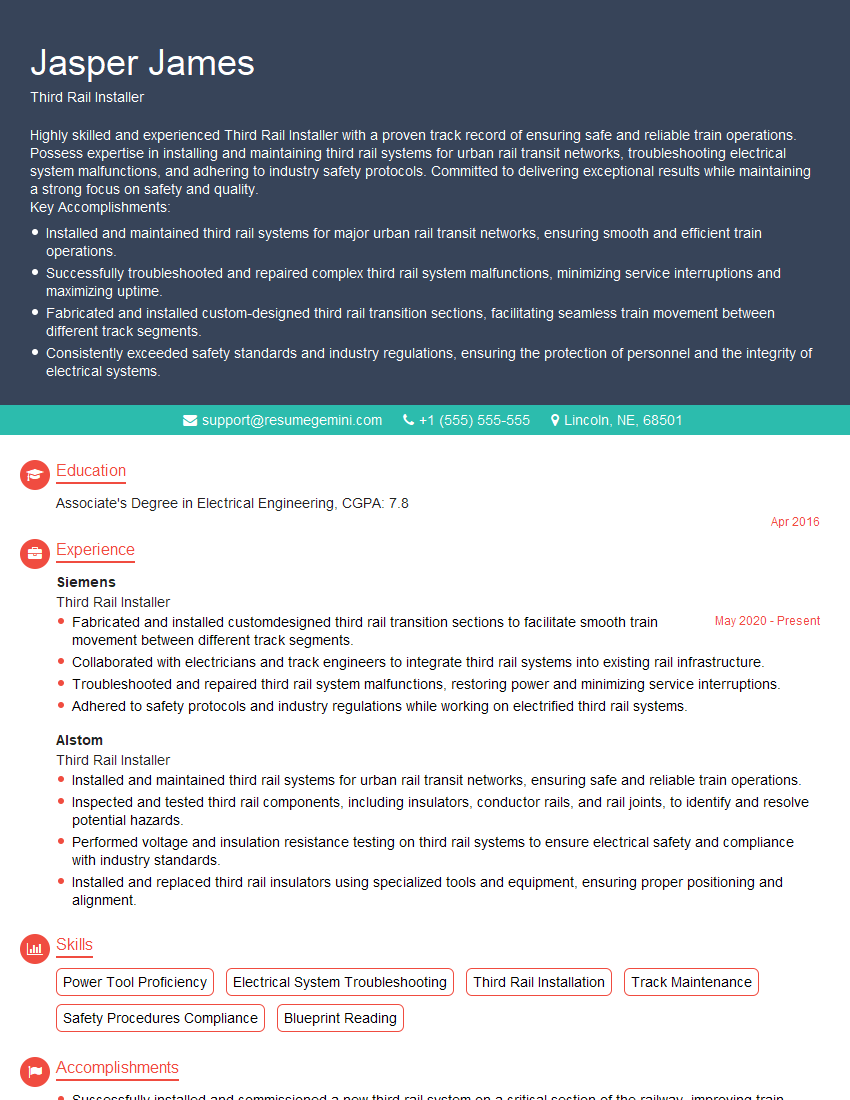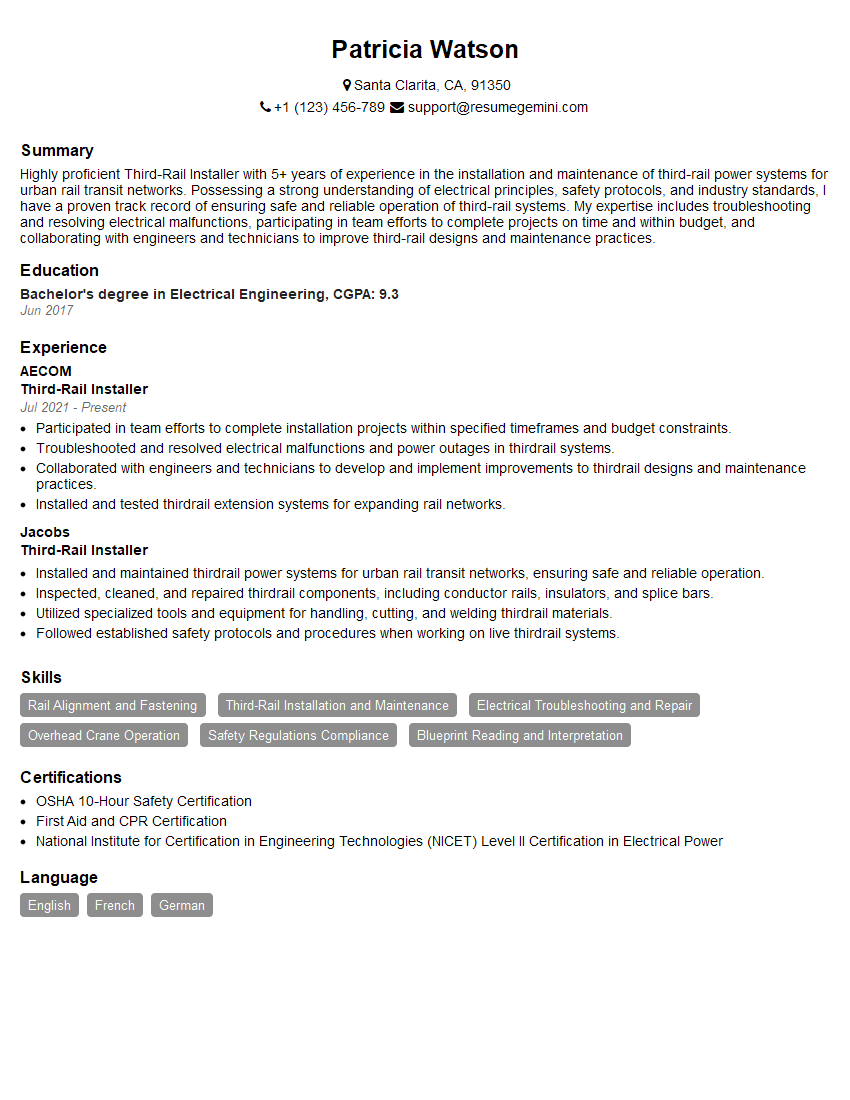Ever felt underprepared for that crucial job interview? Or perhaps you’ve landed the interview but struggled to articulate your skills and experiences effectively? Fear not! We’ve got you covered. In this blog post, we’re diving deep into the Third Rail Installer interview questions that you’re most likely to encounter. But that’s not all. We’ll also provide expert insights into the key responsibilities of a Third Rail Installer so you can tailor your answers to impress potential employers.
Acing the interview is crucial, but landing one requires a compelling resume that gets you noticed. Crafting a professional document that highlights your skills and experience is the first step toward interview success. ResumeGemini can help you build a standout resume that gets you called in for that dream job.
Essential Interview Questions For Third Rail Installer
1. Describe the key responsibilities of a Third Rail Installer?
- Install and maintain third rails, which provide electrical power to trains.
- Ensure that third rails are properly aligned and insulated to prevent electrical hazards.
- Troubleshoot and repair third rail systems as needed.
- Follow safety protocols and wear appropriate protective gear while working on third rails.
2. What are the different types of third rail systems and their advantages and disadvantages?
Third Rail Systems
- DC Third Rail: Uses direct current and typically found in underground rapid transit systems.
- AC Third Rail: Uses alternating current and common in suburban and some high-speed rail systems.
Advantages and Disadvantages
-
DC Third Rail:
- Advantages: Lower maintenance costs, easy to install
- Disadvantages: Limited power capacity, can interfere with electronic devices AC Third Rail:
- Advantages: Higher power capacity, less interference with electronic devices
- Disadvantages: More complex and expensive to install and maintain
3. What are the safety precautions that must be followed when working on third rails?
- Always wear appropriate PPE, including insulated gloves, boots, and a hard hat.
- Never touch a third rail with bare hands or conductive materials.
- Use insulated tools and equipment when working on third rails.
- Be aware of the location of third rails and maintain a safe distance.
- Follow all safety protocols and guidelines established by your employer.
4. What are the common tools and materials used by Third Rail Installers?
- Insulated tools (e.g., pliers, wrenches, screwdrivers)
- Insulated gloves, boots, and hard hat
- Third rails and insulators
- Electrical testing equipment
- Safety signs and barriers
5. How do you ensure the proper alignment and insulation of third rails?
- Use specialized measuring tools to check alignment.
- Adjust the position of rails as needed using insulated tools.
- Install insulators between rails and the ground to prevent electrical leakage.
- Inspect insulators regularly for damage or wear.
6. Describe the steps involved in troubleshooting a third rail system.
- Identify the location and nature of the problem.
- Visually inspect the third rail and insulators for damage.
- Use electrical testing equipment to diagnose the issue.
- Repair or replace damaged components as needed.
- Test the system to ensure it is functioning properly.
7. How do you stay updated on the latest safety regulations and industry best practices for Third Rail Installers?
- Attend industry conferences and workshops.
- Read technical publications and articles.
- Complete online training courses.
- Consult with experienced professionals in the field.
8. What is your experience with working in a team environment on third rail projects?
- Describe your role and responsibilities within the team.
- Highlight how you contributed to the team’s success.
- Share any challenges you faced and how you overcame them.
9. How do you handle working in confined spaces or at heights when installing third rails?
- Describe the safety precautions you take.
- Explain how you use specialized equipment and tools.
- Share any techniques or strategies you use to minimize risks.
10. What are your career goals as a Third Rail Installer?
- Express your passion for the field and your desire to continue developing your skills.
- Outline your aspirations for growth and advancement.
- Discuss how you plan to contribute to the industry in the future.
Interviewers often ask about specific skills and experiences. With ResumeGemini‘s customizable templates, you can tailor your resume to showcase the skills most relevant to the position, making a powerful first impression. Also check out Resume Template specially tailored for Third Rail Installer.
Career Expert Tips:
- Ace those interviews! Prepare effectively by reviewing the Top 50 Most Common Interview Questions on ResumeGemini.
- Navigate your job search with confidence! Explore a wide range of Career Tips on ResumeGemini. Learn about common challenges and recommendations to overcome them.
- Craft the perfect resume! Master the Art of Resume Writing with ResumeGemini’s guide. Showcase your unique qualifications and achievements effectively.
- Great Savings With New Year Deals and Discounts! In 2025, boost your job search and build your dream resume with ResumeGemini’s ATS optimized templates.
Researching the company and tailoring your answers is essential. Once you have a clear understanding of the Third Rail Installer‘s requirements, you can use ResumeGemini to adjust your resume to perfectly match the job description.
Key Job Responsibilities
Third Rail Installers play a crucial role in the construction and maintenance of electrified rail systems. Here are some key responsibilities of the position:
1. Rail and Conductor Installation
Responsible for installing and securing third rail systems, including mounting brackets, insulators, and conductors.
- Ensures proper alignment, spacing, and electrical connectivity of all components.
- Operates specialized equipment such as rail saws, hydraulic benders, and bolt tensioners.
2. Equipment and System Testing
Conducts electrical and mechanical testing of installed systems to ensure compliance with specifications and safety standards.
- Uses specialized testing equipment to verify voltage, resistance, and current flow.
- Reports any discrepancies or potential issues to supervisors for timely resolution.
3. Troubleshooting and Repair
Identifies and resolves issues with existing third rail systems, ensuring uninterrupted operation and safety.
- Diagnoses electrical faults, broken conductors, or damaged insulators.
- Performs repairs efficiently using appropriate techniques and materials.
4. Safety and Regulatory Compliance
Adheres to strict safety protocols and complies with industry regulations while performing all tasks.
- Wears appropriate protective gear, including insulated gloves, goggles, and coveralls.
- Follows established procedures for working in energized environments.
Interview Tips
To ace an interview for a Third Rail Installer position, it is essential to demonstrate your technical skills, knowledge of safety protocols, and a strong work ethic. Here are some tips to help you prepare:
1. Research the Company and Industry
Research the company you are applying to and the broader industry to gain insights into their operations and current trends.
- Visit company website, LinkedIn page, and industry news sources.
- Learn about their projects, safety record, and commitment to quality.
2. Highlight Relevant Skills and Experience
Emphasize your relevant skills, certifications, and experience that match the job requirements.
- Quantify your accomplishments whenever possible, using specific numbers and metrics.
- Prepare examples of your successful installations, repairs, and troubleshooting efforts.
3. Demonstrate Safety Knowledge
Third Rail Installers must have a deep understanding of safety protocols. Highlight your knowledge and commitment to safety in the interview.
- Discuss your adherence to industry standards and best practices.
- Share examples of how you have identified and mitigated potential risks on the job.
4. Be Enthusiastic and Willing to Learn
Third Rail Installers should be passionate about their work and eager to learn new techniques and technologies.
- Express your enthusiasm for working in the industry and your desire to contribute.
- Show that you are eager to take on new challenges and expand your knowledge.
Next Step:
Now that you’re armed with the knowledge of Third Rail Installer interview questions and responsibilities, it’s time to take the next step. Build or refine your resume to highlight your skills and experiences that align with this role. Don’t be afraid to tailor your resume to each specific job application. Finally, start applying for Third Rail Installer positions with confidence. Remember, preparation is key, and with the right approach, you’ll be well on your way to landing your dream job. Build an amazing resume with ResumeGemini

